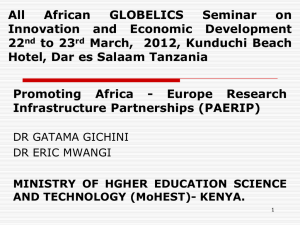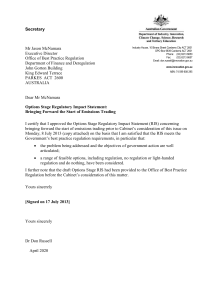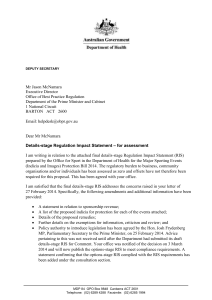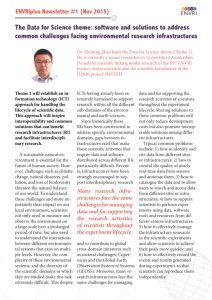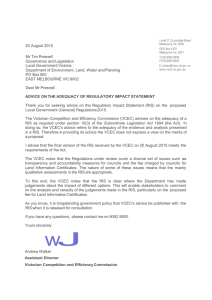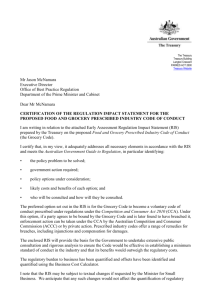annotated agenda - Innovation Policy Platform
advertisement
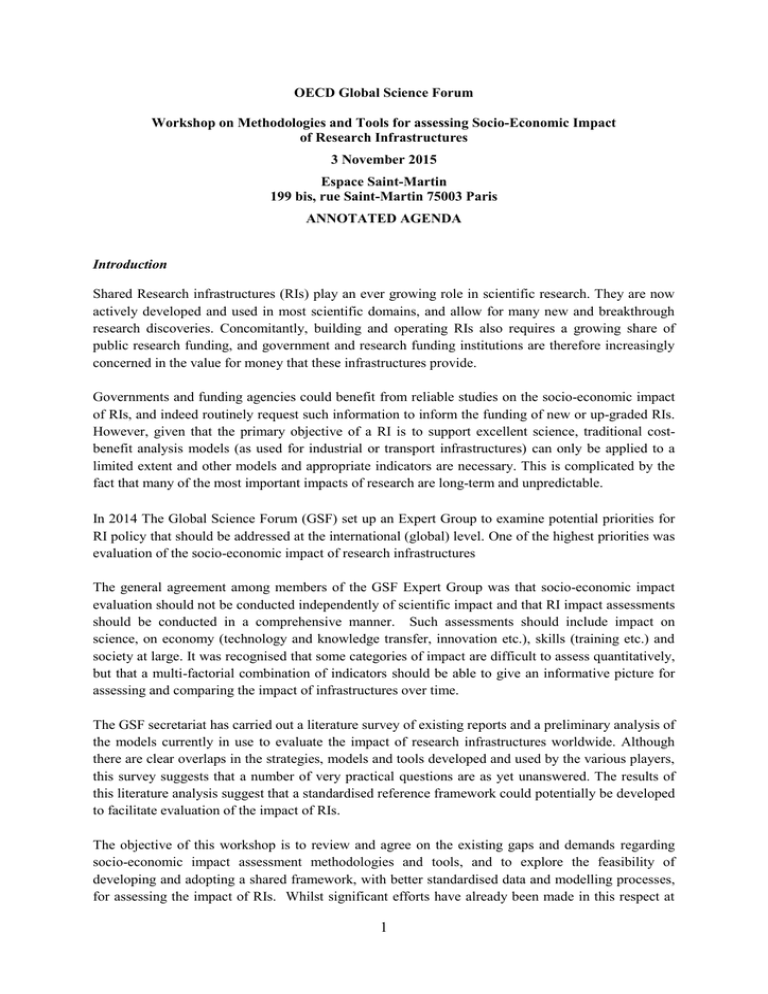
OECD Global Science Forum Workshop on Methodologies and Tools for assessing Socio-Economic Impact of Research Infrastructures 3 November 2015 Espace Saint-Martin 199 bis, rue Saint-Martin 75003 Paris ANNOTATED AGENDA Introduction Shared Research infrastructures (RIs) play an ever growing role in scientific research. They are now actively developed and used in most scientific domains, and allow for many new and breakthrough research discoveries. Concomitantly, building and operating RIs also requires a growing share of public research funding, and government and research funding institutions are therefore increasingly concerned in the value for money that these infrastructures provide. Governments and funding agencies could benefit from reliable studies on the socio-economic impact of RIs, and indeed routinely request such information to inform the funding of new or up-graded RIs. However, given that the primary objective of a RI is to support excellent science, traditional costbenefit analysis models (as used for industrial or transport infrastructures) can only be applied to a limited extent and other models and appropriate indicators are necessary. This is complicated by the fact that many of the most important impacts of research are long-term and unpredictable. In 2014 The Global Science Forum (GSF) set up an Expert Group to examine potential priorities for RI policy that should be addressed at the international (global) level. One of the highest priorities was evaluation of the socio-economic impact of research infrastructures The general agreement among members of the GSF Expert Group was that socio-economic impact evaluation should not be conducted independently of scientific impact and that RI impact assessments should be conducted in a comprehensive manner. Such assessments should include impact on science, on economy (technology and knowledge transfer, innovation etc.), skills (training etc.) and society at large. It was recognised that some categories of impact are difficult to assess quantitatively, but that a multi-factorial combination of indicators should be able to give an informative picture for assessing and comparing the impact of infrastructures over time. The GSF secretariat has carried out a literature survey of existing reports and a preliminary analysis of the models currently in use to evaluate the impact of research infrastructures worldwide. Although there are clear overlaps in the strategies, models and tools developed and used by the various players, this survey suggests that a number of very practical questions are as yet unanswered. The results of this literature analysis suggest that a standardised reference framework could potentially be developed to facilitate evaluation of the impact of RIs. The objective of this workshop is to review and agree on the existing gaps and demands regarding socio-economic impact assessment methodologies and tools, and to explore the feasibility of developing and adopting a shared framework, with better standardised data and modelling processes, for assessing the impact of RIs. Whilst significant efforts have already been made in this respect at 1 the European level, the aim is to explore what is desirable and feasible at a global level. This should take into account needs of funding organisations as well as research infrastructure operators and user communities for different types of research infrastructures. Meeting organisation The meeting will take place room Karnak at the Espace Saint-Martin 199 bis, rue Saint-Martin 75003 Paris Information on the logistics are described in annexe. Draft agenda 9:00 Welcome from French Research Ministry and OECD Secretariat 9:05 Introduction, objectives of the workshop (OECD secretariat) 9:25 Session 1 : Current landscape (Lucilla Alagna, OECD consultant) 09:55 RIs taxonomy and specificities Increasing demand Current diversity in impact assessment models and indicators Identified challenges and remaining gaps Session 2: Socio-economic impact of research infrastructures: current models (moderator: Jean Moulin, BELSPO/ESFRI) Examples of existing state-of-the-art models in the field - Evaluating and Monitoring the Socio-Economic Impact of Investment in Research Infrastructures (Frank Zuijdam, Jelena Angelis, Technopolis) - Cost-Benefit Analysis Framework for evaluating RIs (Massimo Florio, University Milan) - The societal footprint of big science (Edwin Horlings, Rathenau instituut) - EU new impact assessment policy applied to RIs (Reka Rozsavolgyi, EC) 10:55 Coffee break 11:15 Socio-economic impact of research infrastructures: current models (continued) Open discussion 1. What are the methodologies and uses for ex ante and ex post analyses (costbenefit and impact assessments) ? 2. What are the advantages/disadvantages/challenges of different approaches ? 3. How are scientific, economic and social impacts integrated in overall assessments ? 12:30-13:30 lunch 2 13:30 Session 3: Existing indicator categories and data (moderator: Peter van den Besselaar, University of Amsterdam) Examples of current practices Europe single site RI (ESRF, Christian Vettier) Europe distributed RI (PRACE, Philippe Segers) Japan single site RI (Visualising publication and patent clusters and networks for assessing socio-economic impact of RIs, Sonoko Watanabe, MEXT) International distributed RI (SKA, Daniel Adams, South African Department of S&T) Open discussion What are the limitations and challenges in collecting and validating data ? What is the right balance between qualitative and quantitative indicators What are the current gaps between data collected and needs ? 15:10 Coffee break 15:30 Session 4: Desirability and feasibility of common indicator/data set (moderator: Jean Moulin, BELSPO/ESFRI) Developing a common framework for socio-economic impact indicators 1. Defining common needs 2. Can the same framework be developed to assess the diversity of RIs ? 16:30 Session 5: Next step What action might be required by the different stakeholders (governments, funding organisations, international organisations, RI administrations…). 17:15 Conclusions (OECD Secretariat) 17:30 End 3 Annotation to the agenda Annotations to the Agenda (Sessions 1-4) These annotations are based on empirical and analytical material that was compiled or developed during the preparations for the workshop. This work included an extensive literature review and input from experts with experience in assessing the socio-economic impact of research infrastructures. Session 1 Current landscape RIs taxonomy and specificities The term Research Infrastructures covers a broad diversity of organisations with very different objectives and missions (a notional taxonomy was proposed in the GSF report on distributed RIs1, but there are many existing definitions, by ESFRI, GSO etc…). In this workshop, we consider RIs whose primary objective is to perform or facilitate basic research, for which socio-economic impact assessment is usually poorly developed (in contrast with RIs more focused on applied/dual purpose research, such as wind tunnels, for which the business case usually integrates a clearer socioeconomic objective). Increasing demand Ex ante impact assessments are becoming standard practices in the establishment process of new RIs. Most funding agencies now require that such assessment includes a detailed socio-economic component beside the traditional description of the scientific added-value of the new infrastructure. Ex ante impact assessment are also increasingly required for RIs to be included into national or regional roadmaps, which play an important role in the prioritisation of future governments’ investments. Ex post evaluation is also increasingly demanded for RIs upgrades and even for financing their operational costs. However, demand for such socio-economic impact assessments rarely follows standardised or established methodologies. While it is clear that such analyses do increasingly play a role in the funding decision-making process, the criteria that are actually used remain heterogeneous, even though a common framework appears to exist at the European level. Current diversity in impact assessment models and indicators A number of reports and/or research papers have been devoted to analysing the impact of large international research infrastructures (CERN is a typical example2). Recently, similar work has also been focused on distributed and e-research infrastructures and to their particular problems. Socioeconomic impact is rarely studied as a single issue3. Often, reports or models address economic impact, usually using a rigid/traditional economic analysis4, conducted with economic parameters 1. International Distributed Research Infrastructures, GSF, OECD, 2014 http://www.oecd.org/sti/sci-tech/international-distributed-research-infrastructures.pdf 2 The Impacts of Large Research Infrastructures on Economic Innovation and on Society: Case Studies at CERN, GSF, OECD, 2014 http://www.oecd.org/sti/sci-tech/CERN-case-studies.pdf 3 Some useful results in: Social Impact Assessment Methods for research and funding instruments through the study of Productive Interactions between science and society, http://www.siampi.eu/Content/SIAMPI_Final%20report.pdf 4 Hickling Arthur Low, 2013, TRIUMF, http://www.triumf.ca/sites/default/files/HAL- ReturnOnInvestmentStudy-May-2013.pdf Price Waterhouse, 2008, ESS, https://www.skane.se/upload/Webbplatser/Skaneportalenextern/dokument/ESSengPart_one.pdf Matrix Insight, 2009, RIs by FP6, https://ec.europa.eu/research/infrastructures/pdf/csri.pdf 4 similar to those used for industrial or public infrastructures. Social impact, when taken into account, is usually addressed in a more qualitative way, and there is a large heterogeneity among social parameters to be considered. There is however a better defined framework for impact assessment at the European level5, where a large number of studies had been conducted, both for ex ante and ex post analysis. Identified challenges and remaining gaps Socio-economic impact assessments are regularly undertaken for RIs, both ex-ante and ex-post, but remain extremely heterogeneous in their objective, performers and models used. There is indeed no agreed model, shared between funding agencies and/or RIs’ organisations, to measure socio-economic impact. For economic impact assessments, an economic approach applying standard economic analysis models developed for any non-scientific infrastructure is largely used and adapted for RIs (see reference 4). But those are rarely fully validated and have to rely on uneven data input. Traditional “direct” impact indicators are often available, although attribution (what is the exact share of the RI impact into the overall economic impact) is more difficult to determine. Assessing more “indirect” impact (for instance, on the R&D of companies involved in using or building RIs) also appears to be a challenge. Social impact assessments are usually far less developed, and usually rely on more qualitative evaluations, although some metrics are available6. The definition of what constitute a social (or societal) impact is not shared among countries and stakeholders, so can vary greatly between assessments. This creates in itself a challenge for data collection. RIs do collect already a wide range of valuable data that can be used for impact analysis. These data are usually intended to describe infrastructure output. This is primarily related to scientific output (given the primary objective of RIs) but economic/econometric data are also collected, although following more heterogeneous criteria. Social impact data are sometimes available, but those are usually very partial and address only a limited part of potentially valuable social impact. Good quality historical time-series data is rarely available. Better validated output data time series are required in a more standardised format to increase the robustness of socio-economic impact assessment of RIs7. Session 2 Socio-economic impact of research infrastructures: current models Short overview of existing state-of-the-art models in the field Economic models have been used worldwide to analyse the (potential) economic output of RIs in both ex ante and ex post situation. The Technopolis presentation, based on a 2013 report8, will provide a summary of the diversity of economic and societal criteria that can be considered to assess the impacts of RIs, taking into account 5 Adrian Curaj et al: Foresight enriched Research Infrastructure Assessment Methodology (fenRIAM), ISBN: 978-973-711-318-4 http://www.fenriam.eu/overview.html 6 J. Britt Holbrook :Re-assessing the science – society relation: The case of the US National Science Foundation’s broader impacts merit review criterion (1997 – 2011). http://digital.library.unt.edu/ark:/67531/metadc77119 7 see for example:SFTC Impact Framework & Evaluation Strategy, 2014, http://www.stfc.ac.uk/stfc/cache/file/B5D5D5C7-809A-44F3-990FBDC045835BAC.pdf 5 in particular both innovation and technology linked to RIs, and how they can be applied to a wide diversity of RIs. In this regards, it might be interesting to compare the Technopolis classification with that used in a recent review of the socio-economic impact of NASA activities analysed in a comprehensive report9 from the Tauri Group. The presentation from Massimo Florio will highlight the development of a specific economic model10 to help analyse the economic output of RIs, using the CERN Large Hadron Collider (LHC) as a case study. This model shows that a quantitative evaluation of benefits can be made by determining their value to users (scientists, early-stage researchers, businesses, visitors) and non-users (the general public). Four classes of contributions to users are identified: knowledge output, human capital development, technological spill-overs, and cultural effects. Benefits for non-users can be estimated, by analogy to public goods with no immediate practical use (such as environmental preservation), using the willingness to pay as an indicator. Applied to the LHC, this model suggests a 92% probability that benefits would exceed costs during its lifetime. The Rathenau Instituut contribution11 will refer to the societal impact of big science, illustrating the difficulty of identifying adjunctive societal impact for big science facilities using traditional methodologies. Although large scale research facilities do show evidence for creation of networks and communities, quantitative social impact is less evident to identify. The discussion should address how current models and tools can be used to assess RIs impact: there are clearly limitations in identifying indirect impacts and there also is a very broad range of social/societal impact, involving cultural and scientific advancement, technological and scientific training, innovation, international links and exchanges, social awareness on various issues, participation of society to science etc. How detailed or far ranging is the current demand for assessing socio-economic impact of RIs both ex ante and ex post, and how can current models be adapted to provide satisfactory responses? The European Union has developed a new evaluation framework for its flagship research funding programme Horizon 2020. The contribution from the European Commission will report on lesson learned from previous Research Infrastructures ex post evaluation exercises and on the new model and indicators being developed for the mid-term evaluation of H2020. The discussion should address how new models and tools that are being developed can be used for assessing the wider socio-economic impact of RIs, beyond traditional and direct impact evaluation. Session 3 Existing indicator categories and data 8 Technopolis Group, Evaluating and Monitoring the Socio-Economic Impact of Investment in Research Infrastructures,2015, http://www.technopolis-group.com/wpcontent/uploads/2015/04/2015_Technopolis_Group_guide_to_impact_assessment_of_research_infrastructures.p df 9 NASA Socio-Economic Impacts, The Tauri Group, 2013. https://www.nasa.gov/sites/default/files/files/SEINSI.pdf 10 a) Massimo Florio, Emanuela Sirtori, The evaluation of research infrastructures: a Cost Benefit Analysis framework http://wp.demm.unimi.it/tl_files/wp/2014/DEMM-2014_10wp.pdf b) Massimo Florio, Stefano Forte Emanuela Sirtori, Cost-Benefit Analysis of the Large Hadron Collider to 2025 and beyond, arXiv:1507.05638v1 [physics.soc-ph] 20 Jul 2015 http://arxiv.org/abs/1507.05638 11 Edwin Horlings, Thomas Gurney, André Somers, Peter van den Besselaar; The societal footprint of big science, Rathenau Instituut http://www.researchgate.net/publication/266513583_The_societal_footprint_of_big_science 12 (Handsight study by DoD, USA, 1963) http://oai.dtic.mil/oai/oai?verb=getRecord&metadataPrefix=html&identifier=AD0495905 6 This session is intended to review which types of indicators and data are already used/collected, for which use, what are the current challenges and needs, and whether common standards could be developed. Examples of current practices Research infrastructures already collect a vast array of data and information to facilitate their evaluation. Furthermore, in most cases, funding organisations also require some sort of ex ante socioeconomic impact assessment prior the establishment of any major new infrastructure. However, current practices are very diverse, being a function of the type of research infrastructure, funding institution practices, and of the complexity of the project. Different cases will be presented to highlight current practices in the collection and use of indicators for socio-economic assessments: ESRF is typical of single-site international RIs. Christian Vettier will present a recently conducted impact analysis of ESRF, which was carried out in particular to assess the impact of its upgrade programme, and illustrate the type of information available for such assessment. PRACE is a good example of international distributed RIs. Philippe Segers will describe socio-economic indicators, key performance indicators and impact assessment methodologies used for PRACE, highlighting its specificity. Using Spring-8 (the Japanese large synchrotron) as a case study, Sonoko Watanabe will describe a new methodology to visualize the transition between scientific and socioeconomic impact through the analysis of patents and publications related to a research infrastructure. SKA is based on a unique new international partnership involving South Africa, Australia and other partners. Daniel Adams will present the type of elements which have been used to conduct the very detailed ex ante socio-economic impact assessment of this upcoming large RI. Discussion items: Limitations and challenges in collecting and validating data Robust ex post impact assessment requires validated data and information over the whole life time of a given RI. What are the type of data that can be readily collected and verified which can potentially provide most useful information for impact assessment studies, taking into account the existing diversity of RIs ? It is possible to identify the minimum number of shared indicators necessary to build a reliable and consistent impact assessment for different RIs? Qualitative vs quantitative Econometric and scientometric indicators are widely used to evaluate RIs. However, whether those are actually meaningful is contested, and they only provide a narrow picture of impact. Furthermore, there is little consensus over the type of direct social/societal indicators to be used. More qualitative indicators are probably also required, but may be more difficult to validate. What is the range of validated indicators available that can be used to respond to the current demand for socio-economic impact assessment of RIs ? Existing gaps and needs 7 Life cycle and time scale is one of the most obvious challenges in RI impact assessment. Whether you consider the concept, design, building, operations and decommissioning phases, each of which can last several years, different set of indicators are required to evaluate RI impact. For instance, research output typically needs to be evaluated over a long time scale (> 20 years12) to grasp the full scale of impact. Additional challenges relate to attribution (how to identify the specific impact of the RI within a complex system, something already difficult to determine for scientific impact alone), and to additionality factors (for instance, how to evaluate what additional benefit a company is getting as a user or provider of a RI). Session 4 Desirability and feasibility of common indicator/data set Defining a set of agreed and shared indicators could help both funding institutions and RI administrators in defining their RIs impact, improving decisions on funding at different stages and helping comparison between investment in RIs and other types of investments. Many reports and studies had been commissioned to provide a clear picture of the past and/or forecasted impact of RIs before a funding or political decision has to take place and a commonly agreed and validated methodology could help in providing objective input to the process. There are however several challenges: Defining common needs Funding institutions, decision-makers, research infrastructure managers all have slightly different needs for socio-economic impact assessments. Identifying those needs is a prerequisite before defining agreed and shared indicators for impacts. How to deal with difference between single-site research infrastructures, distributed and/or eresearch infrastructures? The term Research Infrastructure actually encompasses a broad diversity of organisations. Their impact, geographically, and on science, economy and society, is therefore extremely variable. Clearly, specific indicators would need to be identified and used for each specific case. Impact assessment might/will differ for scale (national mid-scale versus big international facilities), the type (different impacts for different type of RIs: single sited versus distributed vs virtual) or discipline (technical science versus social sciences and humanities). Could a set of more generic tools be developed and relevant data be readily collected to assess some sort of baseline impact ? Session 5 Next step The section will host an open discussion about possible improved international collaboration that could help in developing a common framework of shared indicators for assessing social-economic impact of RIs. Participant contribution is requested in order to identify and agree on priority actions: what kind of studies, expertise are needed to address the challenges? And which organisations could have a role in taking it forward ? The expected results would be a consensus agreement on additional efforts required to fill existing gaps and needs. 12 (Handsight study by DoD, USA, 1963) http://oai.dtic.mil/oai/oai?verb=getRecord&metadataPrefix=html&identifier=AD0495905 8
